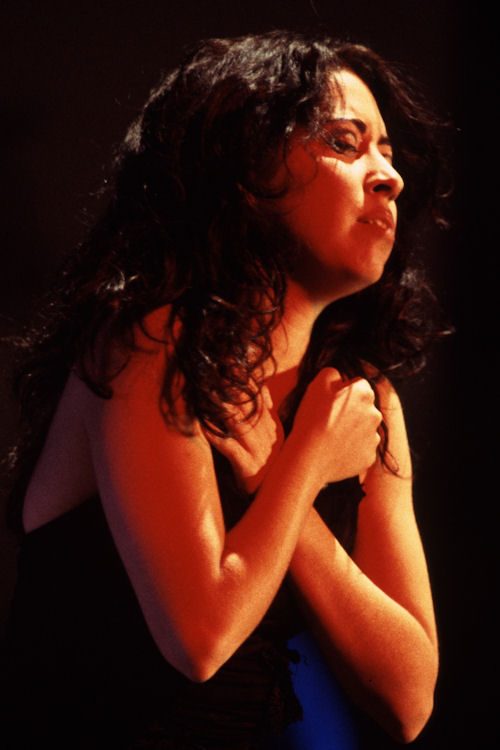Politicized Maria: Tango in San Pedro
 The tango has come a long way. Born in the turn-of-the century slums of Buenos Aires, where it was danced by pimps and prostitutes, by 1968, it had ascended to that most elite of the arts, opera. In that year, Astor Piazzolla, who had been infusing tango with contemporary classical and jazz elements that shocked diehard tango fans, premiered what he termed his tango operito (little tango opera) Maria de Buenos Aires.
The tango has come a long way. Born in the turn-of-the century slums of Buenos Aires, where it was danced by pimps and prostitutes, by 1968, it had ascended to that most elite of the arts, opera. In that year, Astor Piazzolla, who had been infusing tango with contemporary classical and jazz elements that shocked diehard tango fans, premiered what he termed his tango operito (little tango opera) Maria de Buenos Aires.
Combining opera, spoken word, and dance, this haunting piece of theater, with its sizzling libretto by Horacio Ferrer, has been staged in different ways by companies from Brisbane to Pittsburgh. I can safely say that it will be worthwhile to see the upcoming production by Long Beach Opera on January 29 or February 4, 2012 at the Warner Grand Theatre in San Pedro.
By the way, this has nothing to do with the fact that I recently spent three weeks in Argentina.
I did see some spectacular tango dancing in Buenos Aires, and, frankly, it would be hard to find that level of performance in a production such as this, where the dancers are not specialists in tango. But at the preview program on Sunday, January 15, held at the Museum of Latin American Art, LBO artistic director Andreas Mitisek conveyed a deep understanding of Piazzolla’s and Ferrer’s main character. Maria was, as the libretto tells us, “born on a day when God was drunk…born with an insult in her voice.” I had to leave 45 minutes before the end of the two and a half-hour preview program (longer than the opera!), so I can’t say for sure whether the dancers performed a tango or two from the production. We can only hope that choreographer Nannette Brodie does justice to Piazzolla’s nuevo tango score.
 The other wild card for me is Mitisek’s time and setting for the opera — the so-called Dirty War that held Argentina by the throat between 1976 and 1983. Over 30,000 people died or “disappeared” during the reign of the junta that deposed Isabel Martinez de Peròn (Juan Peròn’s third wife). The documentation of murder and torture is horrific. The junta’s power was eventually undermined not only by the economic and political mess it created by launching the Faulkland Islands War, but also from the moral ground it lost through the protests of the “Mothers of the Plaza de Mayo,” who demanded to know the whereabouts of their “disappeared” children.
The other wild card for me is Mitisek’s time and setting for the opera — the so-called Dirty War that held Argentina by the throat between 1976 and 1983. Over 30,000 people died or “disappeared” during the reign of the junta that deposed Isabel Martinez de Peròn (Juan Peròn’s third wife). The documentation of murder and torture is horrific. The junta’s power was eventually undermined not only by the economic and political mess it created by launching the Faulkland Islands War, but also from the moral ground it lost through the protests of the “Mothers of the Plaza de Mayo,” who demanded to know the whereabouts of their “disappeared” children.
Mitisek explained, “Our Maria represents the passion the Argentinian women who were as seductive as the tango while resilient and strong enough to overcome dictatorship in a country machismo ruled. Taking the tango to its most brutal extreme, the Dirty War was a dance of torture, covered in blood, and danced by the highest echelons of society and power.”
Remembering that the Dirty War began eight years after Piazzolla completed Maria, I wouldn’t want this political interpretation to obscure the mythic, timeless figure of Maria. I’m intrigued to see how the production comes together.
Maria de Buenos Aires will be performed in Spanish with English supertitles at the Warner Grand Theater in San Pedro on Sunday, January 29 at 2:00pm and on Saturday, February 4 at 8:00pm. Tickets can be purchased by calling the LBO box office at 562-432-5934 or by going online the LBO website.
Look for tales of my musical travels in Argentina in future Folk Beat columns.
Audrey Coleman is a journalist, educator, and passionate explorer of traditional and world music.













